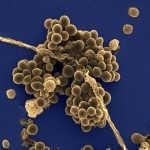Link to Pubmed [PMID] – 23658816
PLoS ONE 2013;8(5):e63244
Group B Streptococcus (GBS) is the leading cause of meningitis in neonates. We have previously shown that plasminogen, once recruited to the GBS cell surface and converted into plasmin by host-derived activators, leads to an enhancement of bacterial virulence. Here, we investigated whether plasmin(ogen) bound at the GBS surface contributes to blood-brain barrier penetration and invasion of the central nervous system. For that purpose, GBS strain NEM316 preincubated with or without plasminogen plus tissue type plasminogen activator was analyzed for the capacity to adhere to, invade and transmigrate the human brain microvascular endothelial cell (hBMEC) monolayer, and to penetrate the central nervous system using a neonatal mouse model. At earlier times of infection, plasmin(ogen)-treated GBS exhibited a significant increase in adherence to and invasion of hBMECs. Later, injury of hBMECs were observed with plasmin(ogen)-treated GBS that displayed a plasmin-like activity. The same results were obtained when hBMECs were incubated with whole human plasma and infected with untreated GBS. To confirm that the observed effects were due to the recruitment and activation of plasminogen on GBS surface, the bacteria were first incubated with epsilon-aminocaproic acid (εACA), an inhibitor of plasminogen binding, and thereafter with plasmin(ogen). A significant decrease in the hBMECs injury that was correlated with a decrease of the GBS surface proteolytic activity was observed. Furthermore, plasmin(ogen)-treated GBS infected more efficiently the brain of neonatal mice than the untreated bacteria, indicating that plasmin(ogen) bound to GBS surface may facilitate the traversal of the blood-brain barrier. A higher survival rate was observed in offspring born from εACA-treated mothers, compared to untreated mice, and no brain infection was detected in these neonates. Our findings suggest that capture of the host plasmin(ogen) by the GBS surface promotes the crossing of the blood-brain barrier and contributes to the establishment of meningitis.


